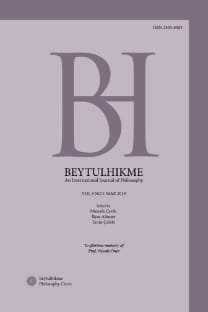Antik Yunan ve Roma Felsefeleri Ekseninde Plotinos Felsefesinde İntihar
Suicide in Plotinus’ Philosophy on the Axis of Ancient Greek and Roman Philosophy
___
- Vernezze, P. J. (2005). Don't Worry, Be Stoic: Ancient Wisdom for Troubled Times. Lanham: University Press of America.
- Sümer, N. (2015). Dinlerin İntihar Olgusuna Bakışı. (Doktora Tezi). Ankara: Ankara Üniversitesi SBE.
- Şen, N. (2008). Batı Düşünce Tarihinde İntiharın Algısal İnşası. Kaygı: Uludağ Üniversitesi Fen-Edebiyat Fakültesi Felsefe Dergisi, 11, 191-202.
- Stephens, W.O. (2014). Epictetus on Fearing Death: Bugbear and Open Door Policy. Ancient Philosophy, 34, 365-391.
- Seneca, L. A. (1995). Seneca’s Phoenissae. (Int. & com. M. Frank). Leiden, New York & Köln: E. J. Brill.
- Seneca, L. A. (1987). Seneca's Hercules Furens. (Int. & com. J. G. Fitch). Ithaca & London: Cornell University Press.
- Seneca, L. A. (1979). Ad Lucilium Epistulae Morales. (Trans. R. M. Gummere). Cambridge, MA: Harvard University Press.
- Ruff, C. A. (1974). The Complexity of Roman Suicide. (MA Thesis). Richmond: Richmond University.
- Rist, J. M. (1996). Man, Soul and Body: Essays in Ancient Thought from Plato to Dionysius. London: Variorum.
- Rist, J. M. (1977). Plotinus: The Road to Reality. Cambridge University Press.
- Porphyry (2017). Plotinus’un Hayatı ve Çalışmalarının Düzenlenmesi Hakkında. (Çev. M. M. Karakaya). Eskiyeni, 35, 113-150.
- Plotinus (1997) Tâsûât Eflûtîn (Terc. F. Cebr). Beyrut: Mektebet Lubnân.
- Plotinus (1969). The Enneads. (Trans. S. MacKenna). London: Faber & Faber Ltd.
- Plato (2001). Phaedo. (Trans. R. Hackforth). Cambridge: Cambridge University Press, 2001.
- Plato (1926). Laws. (Trans. R. G. Bury). London: William Heinemann.
- Pearson, A. C. (1891). The Fragments of Zeno And Cleanthes. London: Cambridge University Press.
- Pattabanoğlu F. Z. (2015). Seneca’da Felsefe ve Ölüm. Süleyman Demirel Üniversitesi Sosyal Bilimler Enstitüsü Dergisi, 22, 137-158.
- Marks, A. H. (2003). Historical Suicide. Handbook of Death and Dying. Thousand Oaks: Sage Publication, 309-318.
- Lucan (1992). Civil War. (Trans. S. H. Braund). Oxford: Oxford University Press.
- Leenaars, A. A. (2004). Psychotherapy with Suicidal People: A Person-Centred Approch. Chichester: John Wiley & Sons.
- Kalogiratou, A. (2009). Plotinus’ Views on Soul, Suicide and Incarnation. ΣΧΟΛΗ, 3 (2), 387–400.
- Kalligas, P. (2014). The Enneads of Plotinus: A Commentary, vol. 1. (Trans. E. K. Fowden & N. Pilavachi). Princeton & Oxford: Princeton University Press.
- Harrison, J. R. (2011). Paul and the Imperial Authorities at Thessalonica and Rome. Tubingen: Mohr Siebeck.
- Epictetus (1877). The Discourses of Epictetus with the Enchiridion and Fragments. (Trans. G. Long). London: George Bell & Sons.
- Edwards, C. (2014). Death and Time. Brill's Companion to Seneca: Philosopher and Dramatist. (Eds. G. Damschen & A. Heil). Leiden & Boston: Brill, 323-342.
- Cholbi, M. (2011). Suicide: The Philosophical Dimensions. Peterborough: Broadview Press.
- Bowersock, G. W. (1995). Martyrdom and Rome. Cambridge: Cambridge University Press.
- Bexley E. (2010). The Myth of the Republic. Lucan’s Bellum Civile: Between Epic Tradition and Aesthetic Innovation. Berlin, New York: De Gruyter, 135-153.
- Barclay, W. (2001). The Gospel of Matthew, vol. II. Louisville: John Knox Press.
- Aster, E. (2005). İlkçağ ve Ortaçağ Felsefe Tarihi. (haz. V. Okur). İstanbul: İm Yayınları.
- Aristotle (2002). Nicomachean Ethics. (Trans. & com. S. Broadie & C. Rowe). Oxford: Oxford University Press.
- ISSN: 1303-8303
- Yayın Aralığı: 4
- Başlangıç: 2011
- Yayıncı: Mustafa Çevik
Yıkıcılık: İnsan Doğasının Bir İç Kavrayışı mı yoksa Toplumsal Yapının Bir Gerçeği mi?
Modern Bir Teşebbüs: Ölümü İnkâr ve Ölümle Mücadele
W. V. Quine, Metafizik ve Pragmatizm
Michael Oakeshott’ın 'Birey' ve 'Kitle İnsanı'nın Ortaya Çıkışı Üzerine Görüşleri
At the Contours of Corporeality: Critique as Will to Power
The Legacy That Frederick Robert Tennant Left to Theism
Bedenselliğin Eşiğinde: Güç İstenci Olarak Eleştiri
ENGİN YURT, NURTEN KİRİŞ YILMAZ
The Missing Piece in Descartes’ Metaphysical Project: Time
Epikür ve Lukretius’un Ölüm ve Yokluk Algılarına Dair Bir Değerlendirme
